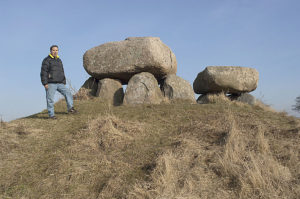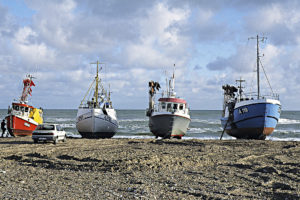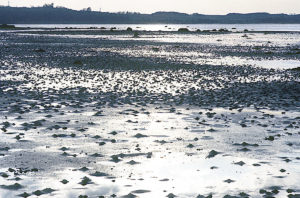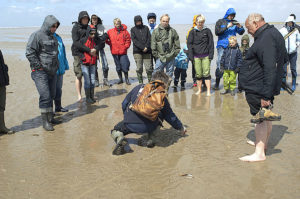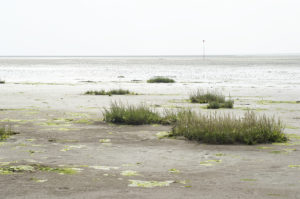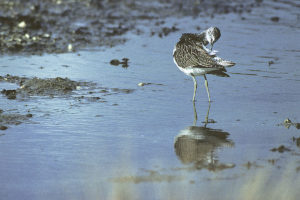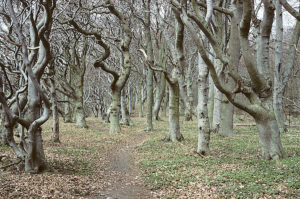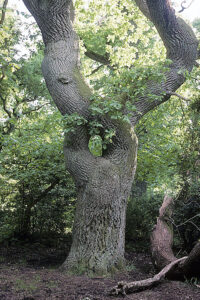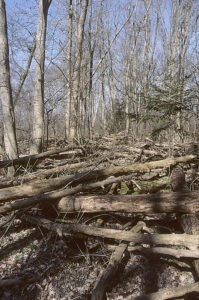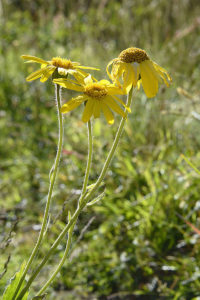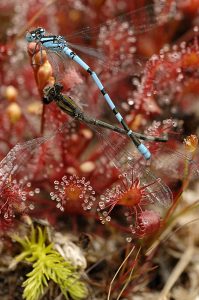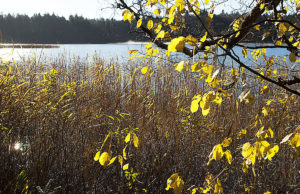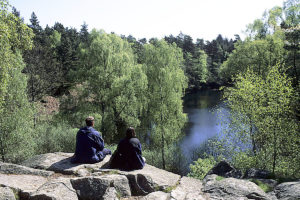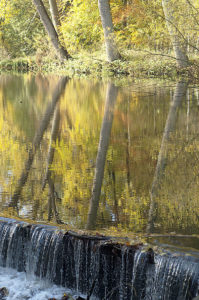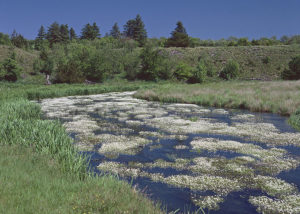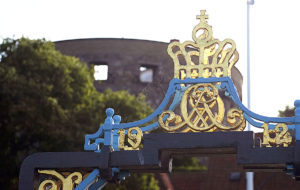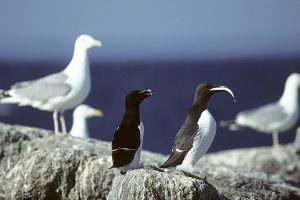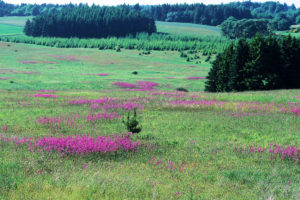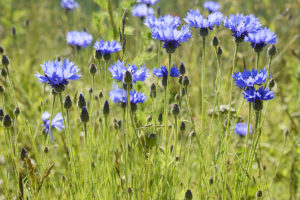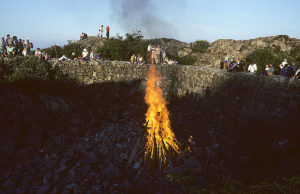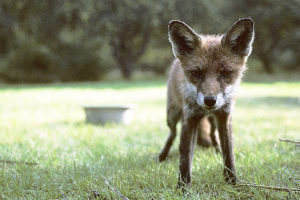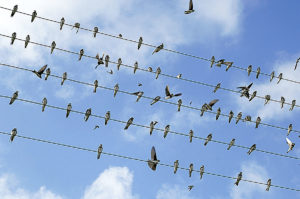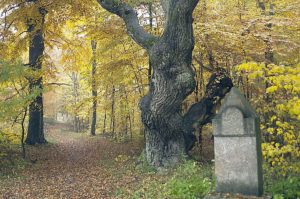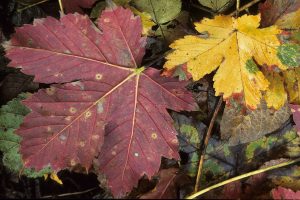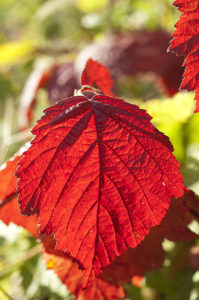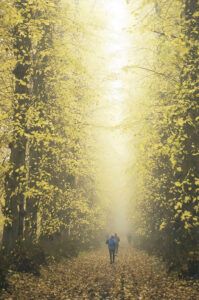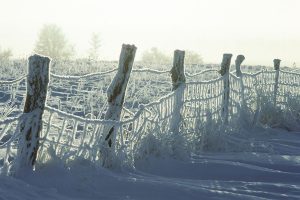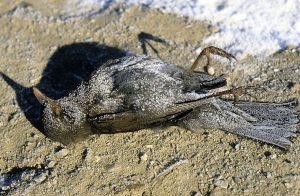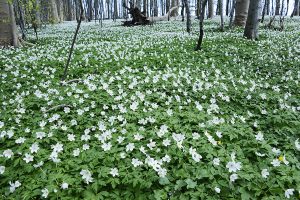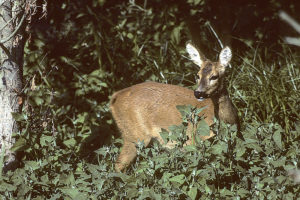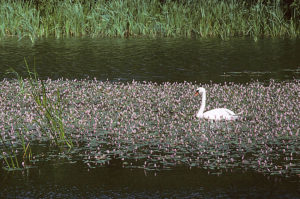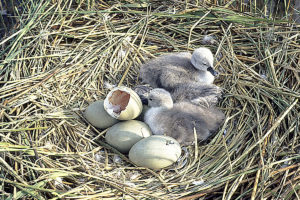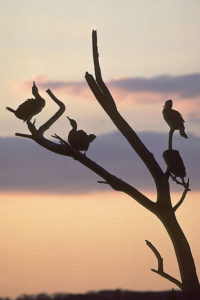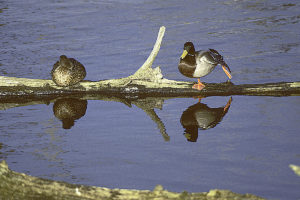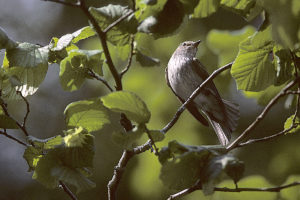Denmark – land of sea and islands
Denmark is a small country in northern Europe, covering a mere 43,000 km2. To many tourists, Denmark is the land of Hans Christian Andersen’s fairy-tales, the statue of the Little Mermaid, posing on her rock in the harbour of the country’s capital, Copenhagen, or Copenhagen’s 150-year-old amusement park, Tivoli. Or maybe Danish pastry?
To many tourists, Denmark is the land of poet Hans Christian Andersen, the statue of the Little Mermaid, or Copenhagen’s 150-year-old amusement park, Tivoli. – In this picture from Tivoli, the so-called ‘Elevator’ accelerates downward, full speed. (Photo copyright © by Kaj Halberg)
During the Stone Age, c. 3000-3500 B.C., numerous dolmens (in Danish ‘dysse’) were erected all over Denmark. This picture shows the Sømarkedyssen, on the island of Møn, south-eastern Denmark. (Photo copyright © by Kaj Halberg)
Nowadays, most fishing vessels in Denmark are anchored in harbours. A few places, though, like here at Torup Strand, northern Jutland, fishermen still haul their boats ashore, using huge winches. (Photo copyright © by Kaj Halberg)
Greatly influenced by the sea
Despite its small size, and the lack of mountains, the landscape of Denmark is surprisingly varied, with many different natural features. Comprising about 500 larger and smaller islands, the country is immensely influenced by the sea. Only the peninsula Jutland is connected to the European continent in the south, to Germany.
Compared to its size, Denmark has a very long coastline, 7,500 km, and no place in the country is further than 52 km from the sea. To the west is the rough North Sea, which, during storms, crashes against coastal cliffs, eroding away sand and clay, which is later deposited elsewhere as long sandbars. Over the years, this process has created several large, shallow fiords. Between Denmark and the Scandinavian Peninsula lies the Kattegat Sea, with more shallow and calm waters, and its southern shores border the Baltic Sea, which stretches east and north, along Poland, the Baltic States, Russia, the east coast of Sweden, and Finland.
Shallow waters
In the south-western corner of Denmark, the North Sea is very shallow. This area is called the Waddensea (meaning ’the sea that you can walk in’), created by changing tides over thousands of years. Tides are a result of the gravitational pull of the Moon, which, every six-and-a-quarter-hours, move immense amounts of sea water, pulling it first in one direction, and then in the other.
The Danish part of these wetlands covers only about one tenth of the entire Waddensea, the majority being situated in Germany and Holland. In the Danish part, high tide brings in about 1 km3 of seawater, causing the water level to rise about 1 m on average, flooding most of the area. During low tide, when the water has receded, a layer of fine sand and organic matter, so-called silt, is left behind. In this way, tides have created huge sand flats, covering about 1,000 km2.
Numerous animals like worms, crustaceans, shrimp, mussels, and snails feed on tiny plankton in the silt. Fishes and birds feed on these animals, and millions of migratory birds rest here in spring and autumn to feed and build up a layer of fat, before continuing their migration. During the summer months, female harbour seals (Phoca vitulina) come ashore on sandy islets to give birth to a single pup.
Late in the day, sunrays are reflected in the shallow waters of a waddensea, situated in Horsens Fjord, eastern Jutland. The numerous small heaps are excreta of lugworms (Arenicola marina). (Photo copyright © by Kaj Halberg)
Nature guide Kirsten Anneberg Stidsholt, explaining the complex biology of The Waddensea to a group of tourists. (Photo copyright © by Kaj Halberg)
Common cordgrass (Spartina anglica) is an invasive species in several areas of waddensea, expelling native species. This picture is from the island of Fanø, western Jutland. – The invasiveness of this species is related on the page Nature: Invasive species. (Photo copyright © by Kaj Halberg)
The greenshank (Tringa nebularia) is very common in Denmark, passing through on migration spring and autumn. This one is preening, standing in shallow water in Horsens Fjord. (Photo copyright © by Kaj Halberg)
Green halls of beech
The national tree of Denmark is the beech (Fagus sylvatica). Stepping into an open forest of these tall and stately trees, you almost feel like standing in a hall of silvery-grey columns, topped by a lush crown of green. Yet, these beech forests, for centuries praised by poets as the symbol of Denmark, are in fact not the original natural vegetation of the country.
Before Stone Age people, about 5,500 years ago, began their slash-and-burn agriculture, forests of oak (Quercus), maple (Acer), elm (Ulmus), linden (Tilia), ash (Fraxinus), and many other tree species covered the country from coast to coast. Much forest was cleared to make more farmland, causing the landscape to become more open. On many hill tops, Stone Age people erected dolmens, burial chambers, constructed of huge stones. Still today, many of these dolmens dot the Danish landscape.
Over the following centuries, throughout the Bronze Age, the Iron Age, and the Middle Ages, further forest was cleared, and by 1800 very little forest indeed remained – a mere 3% of the country was forest-clad. Small pockets of virgin forest only survived on steep hills, on the tip of peninsulas, and on some islets.
Since the Stone Age, many trees were considered sacred, especially huge and hollow ones, which were treated with great respect and often spared, when the forest was cleared. Supposedly, many of these sacred trees possessed healing powers, for instance where two branches joined to form an ‘eye’. As late as in the 19th Century, many people believed that a child with rachitis could be healed by creeping through an ’eye’, preferably on a Thursday night. By this action, the disease would be transferred to the tree.
Widespread planting of trees began in Denmark around 1850, and today almost all forests are manmade. Beech, oak and various conifers are planted in straight rows, only to be cut down decades later and brought to the sawmill. Since the 1990s, however, forest management has changed, many pockets of forest now being designated as ’natural forest’, in which tree felling only takes place on a very small scale. In some of these forests, no management at all takes place, and after a few decades they become completely wild, full of dead and fallen trees. Many threatened species of plants and animals have found a refuge in these natural forests.
Forests of planted beech trees (Fagus sylvatica) are very common in Denmark. These old trees, growing near the coast, are gnarled and twisted – an effect caused by salty winds from the sea. (Photo copyright © by Kaj Halberg)
In Denmark, a common belief in former days was that a child with rachitis could be healed by creeping through an ’eye’ of a tree, where two branches had joined. In this picture, one such tree is seen, a common oak (Quercus robur), named Pramdrageregen, near Gudenå (‘River of the Gods’), eastern Jutland. (Photo copyright © by Kaj Halberg)
Since the 1990s, many forests in Denmark have been designated as ’natural forests’, in which tree-felling is no longer allowed. This picture shows a forest of this type on the scientific reserve of Vorsø, Jutland, with many overturned elms (Ulmus glabra), which were killed by Dutch elm disease. This interesting reserve is presented in depth on the page Nature reserve Vorsø. (Photo copyright © by Kaj Halberg)
Sea of heather
In August, numerous areas around the country are covered in a carpet of violet heather (Calluna vulgaris), a plant which can grow on very poor soils. Areas dominated by heather are called moors. They date back from the Middle Ages, when huge areas of forest were cleared to create farmland. However, in areas of poor and sandy soils, crops could only be harvested for a few years, before nutrients were exhausted. The farms were abandoned, causing heather and a few other hardy plants to invade the former fields. In the 1700s, huge areas in Jutland were covered in heather. During the last 150 years, however, most of the moors have once again been transformed into agricultural lands by ploughing deep and using plenty of chemical fertiliser.
Many other beautiful flowers grow on the moors. In European Middle Age folk medicine, arnica (Arnica montana) was considered a powerful healer. An older name of the plant, of German origin, means ’good against disease’. However, it is in fact very poisonous and should be used with great care.
In humid areas on the moors, several species of sundew (Drosera) can be found. The leaves of these plants are covered in numerous sticky glandular hairs, in which insects and other small animals easily get stuck. The glands contain enzymes, which are able to break down the external chitin layer of the animals, after which the plant can utilize nitrogen and other nutrients in the animal. The glandular drops reflect sunshine, like dew, and an older Danish name of these plants is ‘Virgin Mary’s Tears’. The glandular hairs were collected and sold as a remedy for warts and many other ailments.
Sundew and other flesh-eating plants are described in depth on the page Plants: Carnivorous plants.
Moorland with vegetation of heather (Calluna vulgaris), juniper (Juniperus communis), silver birch (Betula pendula), and bracken (Pteridium aquilinum), Paradisbakkerne, Bornholm. (Photo copyright © by Kaj Halberg)
In European Middle Age folk medicine, arnica was considered a powerful healer. This plant is described in depth on the page Plants: Plants in folklore and poetry. (Photo copyright © by Kaj Halberg)
In this picture, two common blue damselflies (Enallagma cyathigerum) have been trapped in the glandular hairs of oblong-leaved sundew (Drosera intermedia). One has already dried out, while the other has just been caught. (Photo copyright © by Kaj Halberg)
Streams and lakes
Countless brooks and rivers wind through forests, meadows, and farmland. Most of these streams are very small indeed, but as there are thousands of them, their total length amounts to about 64,000 km. Sadly, many watercourses have been converted to straight canals, in order to create more farmland, and many streams are polluted by fertilisers and chemical waste, often killing fish and other wildlife.
The past three or four decades have shown a general improvement in the condition of the rivers. Most waste water is now being treated, and use of chemical fertilizers near rivers has been restricted. Fish like salmon (Salmo salar) and trout (Salmo trutta), which had almost disappeared, have been re-stocked and are now flourishing.
The otter (Lutra lutra) had almost gone extinct in Denmark by 1970, mainly due to hunting and drowning in fish traps. Since 1967, when the species was legally protected, it has made a dramatic comeback. Today, openings of fish traps must be covered by a relatively fine-meshed net, which prevents otters from swimming into the traps.
Hundreds of lakes, large and small, dot the landscape – refuges for fishes, birds, dragonflies, and many other animals. During the 1950s and 1960s, unfortunately, a draining fever was raging in Denmark, causing numerous lakes and marshes to be reclaimed and turned into farmland, and the rest were more or less polluted.
Today, however, lakes are generally much cleaner, many drained lakes have been re-established, and a large number of small waterholes have been established to benefit frogs, toads, and salamanders, as well as other wildlife.
One among numerous lakes near Silkeborg, central Jutland, with vegetation of reed (Phragmites australis) and alder buckthorn (Frangula alnus), displaying yellow autumn foliage. (Photo copyright © by Kaj Halberg)
In recent years many lakes and marshes have been restored, including Solbjerg Engsø, eastern Zealand. Great cormorants (Phalacrocorax carbo) have established a colony in trees in this lake, which died when the water level rose. (Photo copyright © by Kaj Halberg)
Silver birches (Betula pendula), displaying their pale green spring foliage, grow along the shores of this small forest lake, named Grydesø, Paradisbakkerne, Bornholm. (Photo copyright © by Kaj Halberg)
During the Middle Ages, numerous streams were dammed to create ponds, from which the water was led through watermills. Many of these mill ponds have been preserved, as they are important refuges for water insects, fish, amphibians, otter, and many other animals. This picture shows a pond at Lillemølle, south of Nyborg, Funen. (Photo copyright © by Kaj Halberg)
A carpet of pond water-crowfoot (Ranunculus peltatus) covers the surface of Lilleå River, western Jutland. (Photo copyright © by Kaj Halberg)
Bornholm – an isolated island
In the Baltic Sea, about 50 km southeast of Sweden, far to the east of the rest of Denmark, lies the island of Bornholm. The landscape on this island is quite different from other parts of the country, being mainly rocky.
On several occasions during the last 500 years, often for long periods, Bornholm was occupied by Germans or Swedes, and after World War II, in 1945-46, by Russians. But despite their isolated position, people here have always remained faithful to Denmark, proudly considering themselves Danes.
In the 1600s, a number of wars were fought between Denmark and Sweden. The Danish King, Christian V, ordered a fortress erected on a tiny islet near the island of Bornholm, in the Baltic Sea, south of Sweden. Construction took place 1684-1687. This island, which until then had been uninhabited, was named Christiansø, in honour of the king. Later, the neighbouring island was named Frederiksø, in honour of his successor, Frederik IV.
In Denmark, rocky coasts are only found on Bornholm. This rock, called Kamelhovederne (‘The Camel Heads’), has been sculpted by sea waves, wind, and fluctuating temperatures. (Photo copyright © by Kaj Halberg)
The fortress on Christiansø. In the foreground, the monogram of King Christian X adorns a tiny bridge between Christiansø and Frederiksø. (Photo copyright © by Kaj Halberg)
For many years, a rocky islet, Græsholmen, near Christiansø, was the only Danish breeding site for the guillemot (Uria aalge, with a fish) and the razorbill (Alca torda, centre). In later years, both species have also settled on several localities on Bornholm proper. The birds in the background are herring gulls (Larus argentatus). (Photo copyright © by Kaj Halberg)
Long summer days
Denmark lies far to the north, at 55o Northern Latitude. Summer days are up to 17 hours long, and at Midsummer nights are only dark when the sky is overcast. Danes love to sit outside their home on warm summer nights.
Two days after Summer Solstice, on the 23rd of June, countless piles of wood and shrubs are ignited, and people gather around the fires to sing summer songs. In fact, this pleasant custom has its origin in the gruesome Middle Age persecution of witches, who were accused of sorcery and burned at the stake. Today, a ‘witch’, made of straw and dressed in old clothes, is often placed in the fire, sitting on a broom, on which she flies to Bloksbjerg, a hill in Germany, where, reputedly, witches would meet to perform their grisly rituals.
In summer, Denmark is a land of green fields of barley, wheat, rye, oat, sugar beet and other crops, interspersed with small woods, meadows, and streams. By Midsummer, flowers abound in meadows, along forest edges, and on road sides. Birds are busy feeding the next generation, and from waterholes newly transformed frogs and toads emerge by the thousands.
Summer is a lovely time in Denmark. In this fallow field, thousands of sticky catchfly (Silene viscaria) resemble strokes from an artist’s paintbrush. (Photo copyright © by Kaj Halberg)
The cornflower (Centaurea cyanus) used to be a typical flower of corn fields, but has declined drastically after the introduction of chemical herbicides. (Photo copyright © by Kaj Halberg)
Many Danes celebrate Midsummer by lighting a huge fire, gathering around it to sing summer songs. This picture is from the islet of Christiansø, near Bornholm. (Photo copyright © by Kaj Halberg)
The red fox (Vulpes vulpes) is very common in Denmark. Near human habitation it often becomes quite tame, as this pup which has been eating from a dog’s bowl and is now approaching me. The fox is described in depth on the page Animals: Dog family. (Photo copyright © by Kaj Halberg)
Autumn colours
By September, crops have been harvested, and fields lie barren, covered in yellow stubble, or newly ploughed. It is the time for sowing winter wheat.
During the shorter days of October, trees prepare for the winter. Leaves turn red, yellow, or brown, falling silently to the ground, if not a fierce storm tears them off the branches, whirling them around and leaving them in piles. Children love to shuffle their feet through these piles of leaves, which weigh next to nothing. Remember the poem Gathering leaves by American poet Robert Frost (1874-1963)?
Spades take up leaves no better than spoons,
And bags full of leaves are light as balloons.
When the last leaves have fallen, the bare limbs of trees point to the sky, seemingly lifeless. However, at the tip of branches and twigs, buds with new leaves or flowers are ready to burst with the spring warmth.
Numerous pictures, depicting autumn foliage, are presented on the page Autumn.
Migrating birds now leave for warmer parts of the world, and from Scandinavia and Russia, millions of other migrant birds pass through Denmark. Birdwatchers flock around the best birding areas to enjoy the colourful spectacle of huge gatherings of birds.
One of the first signs of autumn is the gathering of large flocks of swallows and martins on electric wires, just before they start their southbound migration. This picture shows sand martins (Riparia riparia). (Photo copyright © by Kaj Halberg)
In autumn, the foliage of most forest trees in Denmark turn yellow or brown. This picture shows an old oak tree (Quercus robur) in Jægerspris Forest, Zealand. (Photo copyright © by Kaj Halberg)
Fallen leaves of a sycamore maple (Acer pseudoplatanus) cover the forest floor. In autumn, the leaves of this species turn either reddish or yellow. (Photo copyright © by Kaj Halberg)
In autumn, leaves of dewberry (Rubus caesius) become scarlet. (Photo copyright © by Kaj Halberg)
Golden-leaved rows of linden trees (Tilia europaea) along a forest road, Jægerspris, Zealand. (Photo copyright © by Kaj Halberg)
Border terrier on a lawn, which has become a yellow carpet of fallen cherry leaves. (Photo copyright © by Kaj Halberg)
Winter quiet
In November, hedgehogs (Erinaceus europaeus), spiny mammals that feed mainly on insects and worms, start hibernating for four to five months, well protected against the winter cold beneath a huge pile of dead leaves. Other mammals, such as red foxes (Vulpes vulpes), badgers (Meles meles), martens (Martes), red squirrels (Sciurus vulgaris), mice, and many others have added a thick layer of fat to prepare for the winter shortage of food.
The short winter days of Denmark are cold and moist, and the sky is often covered by dark, low clouds. During the long nights, hooting owls or the eerie mating call of foxes can be heard. Occasionally, severe cold will prevail for long periods. Snow covers the ground, and the landscape is quiet. Children bring out their sledges or skis from basements and garages, zooming down steep hills, often turning over and getting buried in the soft snow. On the frozen ponds, people love skating. Sometimes the layer of ice on lakes and shallow seas becomes so thick that people arrange car races on the ice.
When snow covers the ground, children bring out their sledges or skis, zooming down steep hills. (Photo copyright © by Kaj Halberg)
During periods of severe cold, trees and fences are covered in a thick layer of rime. (Photo copyright © by Kaj Halberg)
This female blackbird (Turdus merula) succumbed to severe cold, now lying on the ground, frozen stiff. (Photo copyright © by Kaj Halberg)
Sweet spring
Usually, the longer days of March bring forth hardy flowers, and the first migrant birds return from the south. April weather can be fierce, with sudden cold showers of hail or sleet. But it is the flowering time of the most typical of all Danish flowers: the white anemone (Anemone nemorosa). Carpets of these delicate white flowers cover countless forest floors.
May is the sweet spring time, full of flowers and bird song. Danes put away their winter clothes and stroll in the forests. The beech now unfolds its lovely, pale green leaves. They have a pleasant, slightly acid taste, but only when they are young. After just a few days, their taste becomes bitter. Everywhere, bright yellow fields of flowering rapeseed dot the landscape.
Birds are now very busy building nests and laying eggs, but some hardy birds like cormorants and ravens (Corvus corax) already have fledged young. Roe deer (Capreolus capreolus) give birth to their fawns, usually twins. The fawns are speckled, making them blend well with the surroundings, when they lie without moving among dead leaves on the forest floor.
The white anemone is the national flower of Denmark. In spring, carpets of delicate white flowers cover the forest floor. (Photo copyright © by Kaj Halberg)
In spring, bright yellow fields of flowering rapeseed dot the landscape everywhere, as here behind poplars (Populus) on Stevns, Zealand. (Photo copyright © by Kaj Halberg)
The roe deer is very common in Denmark. This female is foraging on lush vegetation of red goosefoot (Chenopodium rubrum). (Photo copyright © by Kaj Halberg)
Roe deer fawns are speckled, making them blend well with the surroundings, when they lie without moving among dead leaves on the forest floor. (Photo copyright © by Kaj Halberg)
Some common breeding birds of Denmark
In 1984, the mute swan (Cygnus olor) was elected the national bird of Denmark – an appropriate choice, as it is very common. This was not always the case. In the 1800s, swans were hunted in Denmark, and by 1920, only three or four pairs were breeding in the vicinity of Copenhagen. Swans were protected in 1926, and the mute swan soon began spreading across the country.
Mute swan, swimming among flowering water-pinkweed (Polygonum amphibium), Lake Flyndersø, Jutland. (Photo copyright © by Kaj Halberg)
Young mute swans are grey, inspiring Hans Christian Andersen to write his famous fairy-tale, The Ugly Duckling – in fact an account of his own life. (Photo copyright © by Kaj Halberg)
The common eider (Somateria mollissima) has an almost circumpolar distribution, found along Arctic coasts in Europe, eastern Siberia, and North America. It also breeds in some northern temperate areas, including Denmark. Formerly, it was common along Danish coasts, but in later years it has decreased, probably due to a combination of disease and diminishing food resources.
This incubating female eider on the islets of Mågeøerne, Funen, is very well camouflaged, causing her not to leave her nest despite the proximity of people. (Photo copyright © by Kaj Halberg)
During the 1800s, the great cormorant (Phalacrocorax carbo) was persecuted all over Europe, partly because it was competing with fishermen, partly because its guano was destroying the trees, in which it was breeding. This bird has an extremely wide, but rather patchy, distribution, found all over Europe and most of Asia, in Australia and New Zealand, and in north-eastern North America and Greenland. Formerly, the white-breasted cormorant of Africa was also included in this species, but today most authorities recognize African birds as a full species, P. lucidus.
The generic name Phalacrocorax is from the Greek phalakros (‘bald’) and korax (‘raven’), while the specific name carbo is Latin, meaning ‘coal’, thus ‘the coal-black, bald raven’, where bald refers to the white crown (albeit feathered) of the great cormorant during the breeding season. After being severely persecuted in Denmark for hundreds of years, this species was protected in 1971, and has since then made a dramatic comeback.
Incidentally, fishermen at various localities in China have been using tamed cormorants of this species for fishing for thousands of years. Pictures, depicting this practice, are shown on the page Fishing.
In this picture, cormorants are outlined against an orange evening sky at their night roost on the island of Vorsø, Horsens Fjord, where this species returned in 1944 after an absence of more than 60 years. (Photo copyright © by Kaj Halberg)
The starling (Sturnus vulgaris) used to be very common in Denmark, but has declined dramatically in later years due to diminishing feeding areas in grasslands, caused by the majority of cattle now being kept indoor year-round. It is also being persecuted in its wintering areas. In later years, it has begun to spend the night in cities, where it is considered a nuisance because of its droppings. It also does some damage on fruit trees and other crops.
This male starling, in his shimmering breeding plumage, is singing outside his nesting box. (Photo copyright © by Kaj Halberg)
In Norse religion, the raven (Corvus corax) was the messenger of the supreme god Odin. It used to be fairly common in Denmark, but by the 1960s, it had almost been eradicated by hunting and poisoning. Since the 1990s, it has made a dramatic comeback, and today it is quite common in many parts of the country.
Biologist Ib Krag Petersen has removed a raven chick from its nest to ring it. (Photo copyright © by Kaj Halberg)
The mallard (Anas platyrhynchos) is widely distributed across northern Eurasia and North America. The drake is a gorgeous bird in breeding plumage, with grey sides, purple breast, and glossy-green head, having a blue shine from certain angles. The female is a uniform speckled brown.
This species is very common in Denmark, its numbers greatly increased by hunters, who release large numbers of this species. The released ducks are mainly of Russian descent, and today the original indigenous mallard of Denmark is probably extinct due to hybridization with released birds.
Standing on a log in a small pond, this male mallard is stretching a leg, while a female is sleeping beside him. (Photo copyright © by Kaj Halberg)
The spotted flycatcher (Muscicapa striata) is a fairly widespread breeding bird in Denmark.
Spotted flycatcher, sitting in a hazel tree (Corylus avellana). (Photo copyright © by Kaj Halberg)
This account is an expanded version of an article, published (in Chinese) in a Taiwanese newspaper, Liberty Times, on January 29, 2004.
(Uploaded February 2016)
(Latest update October 2022)

